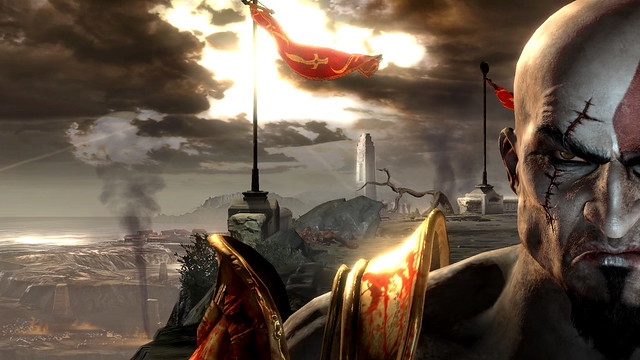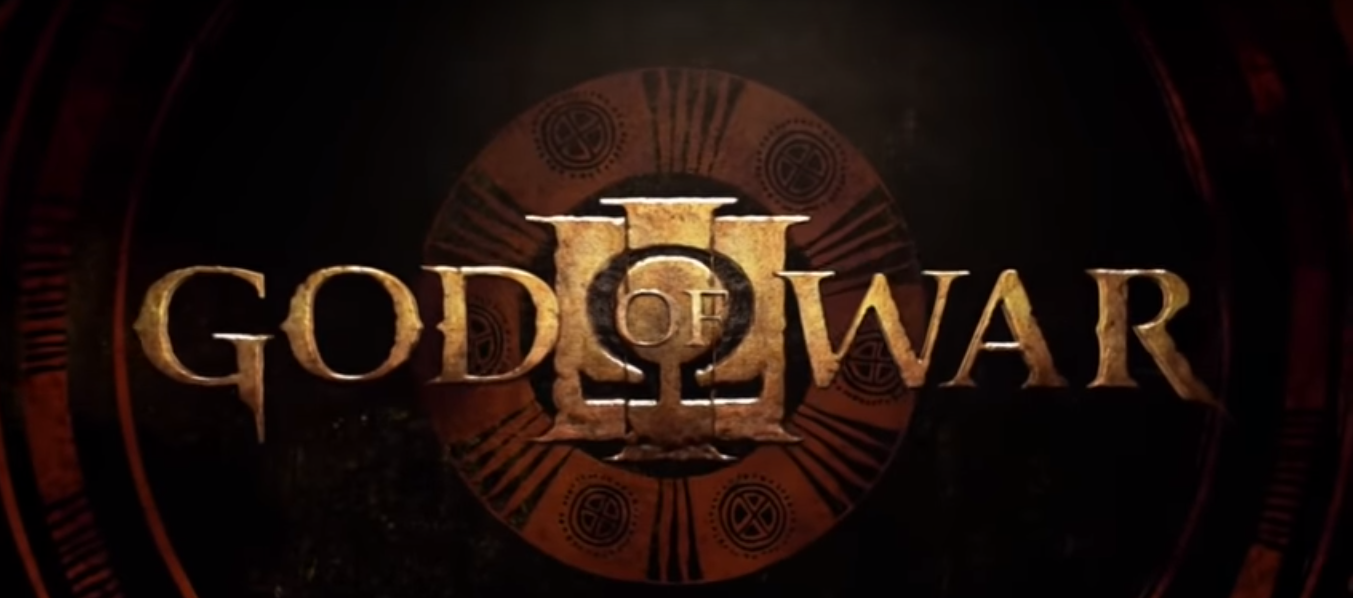The “Summer of War” continues, as Henry Wolski reviews God of War III, the finale to the original trilogy and the franchise’s first installment on the PlayStation 3. Will it end the Ghost of Sparta’s story with a bang or a whimper?
Check out his thoughts on the previous games here:
God of War is currently becoming one of my favorite franchises. The first game was an epic trek across Greek mythology with a revenge motif. The sequel upped the anty with Kratos fighting to save his life and manipulate all of time and space to get vengeance on his father, Zeus.
God of War III caps off the trilogy with Kratos primed and ready to take his fury out on all the Gods of Olympus, no matter the cost.
It’s simple but effective storytelling, as the main event is still the fantastic gameplay and level design.
Santa Monica Studios had a new sandbox to play with for this game, as it was the first in the series to be released for the PS3, and they took advantage of everything the system had to offer.
Environments are bigger in size, scope and scale, character models look very nice and much more refined compared to previous games and new touches are put to make the already smooth as butter combat even more seamless.
The Story (Spoilers Ahead)

As this is the culmination of Kratos’ revenge, you kill a lot of characters in God of War III. Titans, Gods, Demigods or Mortals, it doesn’t matter, they’ve all wronged The Ghost of Sparta somehow and it’s time to collect.
It all starts as Kratos rides Gaia’s back as she and the rest of the Titans scale Mount Olympus. The rest of the God’s begin their counter-attack and Kratos kills Poseidon by snapping his neck and ripping his eyes out.
This action is shown from the perception of Poseidon and it’s pretty disturbing, upping the ante on the violence of the previous games in the series.
Zeus then attacks Gaia and in the struggle she lets Kratos fall off into the River Styx of Hades, telling Kratos that he was just a pawn in the Titans’ revenge on the Gods.
Kratos loses all of his power from the souls of the Styx and meets Athena (she states that she is in a new plane of existence), who gives him the Blades of Exile and tells him to find the Flame of Olympus, the only way to stop Zeus.
With that Kratos fights his way out of hell (for the third time), killing Hades. From then on he fights through Olympus to reach Zeus, killing Gaia, Cronos, Hermes, Hercules, Hera, Hephaestus and Helios in the process, gaining their abilities and plunging Athens into massive decay.
Kratos later learns that the Flame holds Pandora’s box, the only thing that can kill a god. To get it, he must go through the Labyrinth and release Pandora, the imprisoned daughter of Hephaestus.
There are some twists and turns during and after the inevitable final showdown between Kratos and Zeus, but I won’t spoil them for people that want to get the most out of the game’s story.
Some of these developments feel thrown out of left field but it is a satisfying conclusion to Kratos’ story and wraps up the saga quite well.
Huge Ambitions

God of War III is a graphical powerhouse, improving tenfold on the graphics of the first two games. This is impressive since the first two games were some of the best looking titles on the PlayStation 2.
The character models each hold an insane amount of detail, Kratos in particular as well. You see every scar on his body, every shining piece of light reflecting off his gear and every wrinkle on his clothing.
Then there’s the blood. Because the previous games weren’t bloody enough, this game borders on ridiculous with the gore. As mentioned, Poseidon’s eyes are plucked out in gruesome fashion.
Everyone else gets a bloody death as well, with characters being beheaded and dismembered. The creatures Kratos faces also get some delightfully gory kills as well, such as how the Centaur Generals are killed by slicing their stomachs open and watching their guts spill out.
One sequence is particularly memorable for me, as Kratos forces Posideon’s slave/lover to open a puzzle, and then she loses her grip and is ground into the gears working the mechanism. It’s the one time the game almost went too far for me with the gore, as the woman hadn’t done anything to deserve her fate and it just felt cruel.
However, it might just be me, as Kratos has always been an indiscriminate killing machine, burning people alive, murdering innocent civilians fleeing and even throwing a solider into a gear and grinding him to death in God of War II.
If you love borderline gratuitous violence akin to a Quinton Tarantino film, you won’t have any problem with this game’s gore.
Regardless, Kratos is a bloody mess after wasting a few enemies and the blood stays on his skin for quite a while.
In addition, the PS3 helped the game increase it’s already massive scale. Kratos still feels like a tiny ant fighting off massive forces that just want him dead.
Many sections are played on top of or on entire bodies of the massive Titans freed by Kratos. Of course, they betray him and Kratos feels the need to kill them all.
One of the highlights of the game is when Kratos must scale the Titan Cronos, as his body is massive and is as big as some levels from the previous games.

Santa Monica Studios used the PS3 to its full potential and created a breathtaking visual experience with this game.
Third Verse, Same as the First Two
Similarly to the previous two games, Kratos’ main weapon is the Blades of Exile, chains attached to his arms that he uses to slice and dice his enemies.
You can unlock all of the same moves and combos from the last game, and the Blade of Olympus makes a comeback. The Blade is used in rage mode only and cuts through your foes.
The Golden Fleece returns as well, and allows you to block enemy attacks and counter them to great effect. The player can also still breathe underwater and use Icarus’ wings to glide and make difficult jumps.
The Icarus Wings serve a new gameplay purpose, taking the place of the Pegasus sections from God of War II. Jumping on heat vents send Kratos flying through the air to travel between the Chain of Balance and other areas you’ll explore.

These sections are exciting, as you travel a great distance avoiding obstacles, debris and giant boulders destroying the environment and hurling toward you. It’s a welcome change of pace to break up long sections of combat.
Each God you kill gives Kratos new weapons and items to traverse through Athens. These include the Claws of Hades, Nemean Cestus (given after killing Hercules) and the Nemesis Whip.
The whip and claws play similarly to the Blades of Exile, but are aesthetically different and have minor differences in their range and damage given. The Cestus are dual gauntlets that breakthrough barriers and enemy shields.
Kratos also earns the Bow of Apollo to shoot down enemies and set bristle paths on fire.
Another item Kratos earns is the literal head of Helios, the Sun god. Pulling it out will reveal secrets such as chests and doors hidden behind huge walls or just in the background. It also has a combat use as it blinds enemies briefly.

The final items Kratos collects are the boots of Hermes, the messenger god. These will allow him to climb up walls and run through enemies.
Magic returns and is pretty different from God of War II, as each magic attack is connected to a particular weapon.
The player starts out with the Army of Sparta. It summons fallen spartan warriors that put a phalanx around Kratos that does massive damage.
The next power is the Soul Summon that gives you a selection of beasts that you can send out to your enemies. Kratos can also create a wave of energy with the Nemean Cestus and shock several foes with a blast from the Nemesis Whip.
These new additions to the smooth as butter combat keep the gameplay from feeling repetitive and gives the player something new to use around every corner.
Switching between weapons is now incredibly seamless, as each directional button is mapped to one of the four weapons. It streamlines the process of picking a new weapon and skips going to the pause screen to do so.
A small change I want to mention as well is the placement of the button prompts during the game’s many quick-time events (QTEs). These mainly occur when finishing off the bigger enemies in the game and in the final phase of boss battles.
In previous games, the buttons would pop up above Kratos’ head, right next to the action. In this game they show up on their respective positions on the PS3 controller.
So for example, the X button would show on the bottom of the screen, and the O would be in the middle of the right side of the screen.
It’s very disorienting at first and I suffered a few early deaths because I wasn’t ready for them, but in the long run, I think the placement of the prompts make these climactic fights more immersive.
Small quality of life changes like these make the already exhilarating combat even more seamless and the game more enjoyable than ever.
While some media outlets saw the familiarity of the gameplay as a negative, I didn’t and the fact that it still holds up just as well three games in is a testament to how fluid and fun hacking and slashing through the many men and monsters of Greek mythology can be.
Going Out in Style

God of War III is a tour de force that closes the bloody revenge tale of Kratos with a bang. The story is epic and ties up every loose end in the series and overall gives Kratos’ tale a satisfying end.
It retains the best parts of the series, such as massive combat battles against hordes of formidable foes and enjoyable puzzle solving. It adds new weapons and gameplay mechanics that build upon the solid foundation of the series.
The jump to the next generation upped the ante and created a sense of scale appropriate for the finale of the trilogy.
I really don’t have many complaints about this game. It’s God of War at its most refined. I would say that this is the best game out of the trilogy and is well worth your time if you had fun with the other games.
Rating: 10/10
Yet, I know what you’re thinking, there are quite a few more God of War games out there.
There are handheld spinoffs, a prequel that I haven’t heard a lot about, and a little game released last year that throws Kratos into Norse mythology and radically changes the gameplay and story presentation of the series.
However, you can rest easy, as I’ll be looking at the rest of the series for the rest of the summer, starting with the two PlayStation Portable (PSP) games, God of War: Ascension and then closing it off with God of War (2018).
Henry Wolski
Executive Editor

